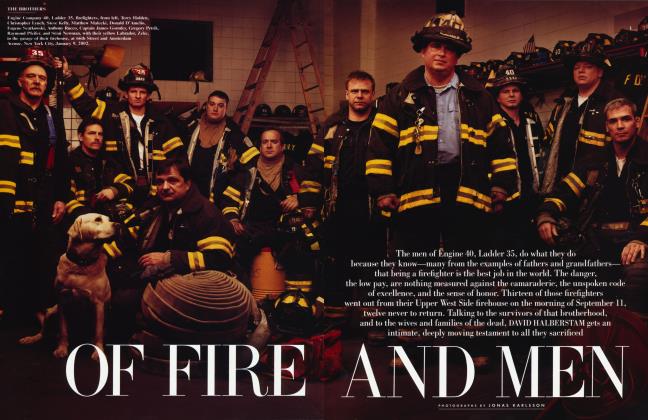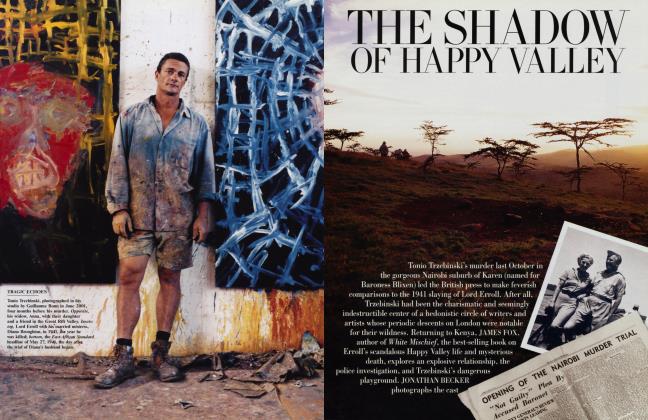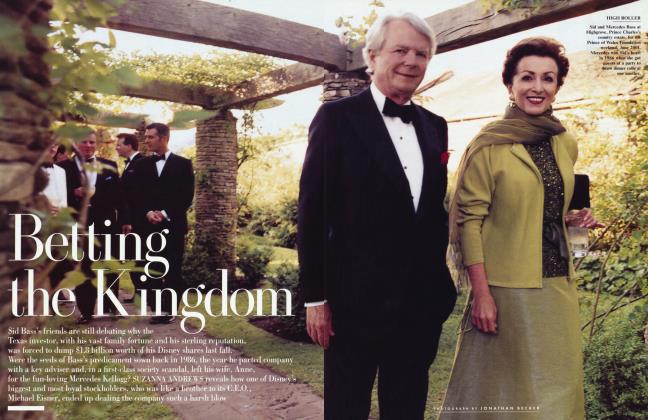Sign In to Your Account
Subscribers have complete access to the archive.
Sign In Not a Subscriber?Join NowCONTRIBUTORS
Special correspondent Maureen Orth brought a unique perspective to her article this month on drugs and terrorism in Central Asia. “I felt like I was reliving parts of my Peace Corps experience,” says Orth, who years ago, as a Peace Corps volunteer in Medellin, Colombia, witnessed the collapse of that country due to the drug trade. There were hardships on her current assignment, from the grueling travel logistics to the old Soviet-style bureaucracy she sometimes encountered. “Every day was a struggle,” says Orth (with a border guard in Tajikistan), who credits the United Nations Office for Drug Control and Crime Prevention for helping her handle these obstacles. “At the same time, it was exhilarating. You can’t separate terrorism from drugs, and I don’t think many people understand that. That’s a tragic and important story to report.”
On page 210, contributing editor David Halberstam profiles the members of Engine 40, Ladder 35— an Upper West Side firehouse that lost 12 men at the World Trade Center on September 11. “This story moved me more than anything else I’ve written about in years. I was engaged as I haven’t been in almost 40 years, since I was a young reporter in Vietnam,” says Halberstam, who lives just three blocks from the firehouse and became something of a regular there over three months. Coming from the Pulitzer Prizewinning author of 17 books, including the 1973 classic The Best and the Brightest, that’s saying quite a bit. Halberstam plans to expand this extraordinary portrait into a book, to be published in the spring by Hyperion.
CONTINUED ON PAGE 86
CONTINUED FROM PAGE 85
After 12 years James Fox returned to Nairobi—where White Mischief, his famous account of the 1941 slaying of Lord Erroll, was set—to report on the murder of artist Tonio Trzebinski. Though the two deaths have been widely compared, Fox doesn’t see it that way. “The current group was very different from the generations I wrote about in White Mischief, except for their romantic and possessive attitude toward East Africa,” says Fox, who first met Trzebinski in 1966 while working with his mother at Nairobi’s Daily Nation. “They seem to have nothing to do with the politics of the place, except insofar as it threatens them with violence.” Fox’s acclaimed Five Sisters: The Langhornes of Virginia was published in paperback last year.
When contributing editor Suzanna Andrews first heard that Fort Worth billionaire Sid Bass had dumped millions of his family’s Disney shares in an effort to meet margin calls in late September, she thought, “Talk about being between a rock and a hard place, poor man. I almost felt sorry for him.” Still, having recently written about such hardened subjects as former nightclub kingpin Chris Paciello and convicted murderers Sante and Kenneth Kimes, Andrews found writing about Bass “an interesting reportorial journey. I almost never write stories about people I would want to have dinner with,” she says. “Bass was really one of the few people from whom I thought I wouldn’t run screaming out of the restaurant.”
Contributing editor David Kamp is familiar with the fanatic buildup that accompanies a new Star Wars film—after all, in 1999 he interviewed George Lucas for an exclusive V.F preview of The Phantom Menace. This time around, though, Kamp found the director a bit testier. “The Phantom Menace got a surprisingly mixed reaction, so now he’s got some fight in him,” Kamp says. “He was showing more pique and taking a more argumentative tack than he did the last time.” According to Kamp, the fifth film in the series, Episode 11Attack of the Clones, due out this May, “seems less explicitly a kids’ movie, a little more grown-up.”
CONTINUED ON PAGE 88
CONTINUED FROM PAGE 86
Contributing photographer Jonathan Becker traveled deep into the heart of lush Karen-Langata, Nairobi, to capture the lifestyles and many faces of those closest to murdered South African artist Tonio Trzebinski for James Fox’s “The Shadow of Happy Valley,” on page 236. One such face was Michael CunninghamReid (shown here, at left, with Becker), who, in a bizarre twist of fate, turned out to have family ties not only to Trzebinski but also to Lord Erroll, whose famous 1941 slaying occurred in the same white enclave. This May, Becker will have two books published: Bright Young Things London (Assouline) and Studios by the Sea: Artists of Long Island’s East End (Abrams), an expansion of the August 2000 V.F. story he collaborated on with Bob Colacello.
Long fascinated by Judy Garland, Jonathan Van Meter recently became interested in her daughter Liza Minnelli, who, with the help of her fiance and manager, David Gest, is hoping to resurrect her career. “She is the only person alive today who calls to mind three different eras: the MGMmusical era, the Rat Pack of the 60s, and the Warhol 70s,” says Van Meter, whose article starts on page 220. But meeting Minnelli was a bittersweet experience. “She is a genuinely warm and affectionate person,” he says. “But you can see the tragedy etched on her face.” A contributing editor at Vogue, Van Meter is at work on The Last Good Time, a book about fabled Atlantic City 500 Club owner Skinny D’Amato.
For contributing editor Steve Garbarino, interviewing Michael Cimino, “the Howard Hughes of directors,” was a study in the fine art of appearances. But reclusive as the physically altered, Academy Awardwinning director of The Deer Hunter has been, Garbarino found him to be, in some respects, in step with the current Zeitgeist. “No one appears to be who they are these days, and a lot of people aren’t comfortable in their own skin,” Garbarino says. Although Garbarino himself has never considered plastic surgery, he has just completed a screenplay called Nip and Tuck. “It’s a sort of Shampoo set in an L.A. plastic-surgery salon,” he says.
CONTINUED ON PAGE 93
CONTINUED FROM PAGE 88
Though he hadn’t been photographed for a magazine in 20 years and has a reputation for being, well, eccentric, director and novelist Michael Cimino was a dream subject for contributing photographer Herb Ritts. “He brought his own gear and told me, ‘I trust you. Do whatever you want.’ I’d say he was the least difficult person I’ve ever phtographed,” recalls Ritts, whose recent credits include back-to-back V.F. cover shoots of Brad Pitt and Tom Cruise, videos for ’NSync, Britney Spears, and Jennifer Lopez, and some television commercials. “It’s fun to mix it up,” Ritts says. “I enjoy the moving imagery.”
When enlisted to help launch Vanity Fair’s new culture section in 1999, Fanfair editor John Gillies felt the pairing was a perfect match. “I own more CDs than I can fit in my apartment and have probably watched more movies and television than a sane person should,” says Gillies, who started out at V.F. as an intern in 1995 and now oversees Fanfair’s music, film, and television coverage. But being a huge music fan has not made interviewing his musical heroes, such as Frank Black and ex-Pavement front man Stephen Malkmus, any easier. “It took a lot of effort for me not to sound like a reporter for Teen Beat, ” says Gillies. “I don’t think ‘You rock!’ is one of the hard-hitting questions they were expecting.”
For photographer Patrick McMullan, a fixture at New York’s most glamorous parties, combining work and play is an everyday occurrence. Take, for example, the recent wedding of political scion Chris Cuomo and Manhattan File founder Cristina Greeven, the subject of this month’s V.F. Camera. “Both the bride and groom are very good friends of mine, so these are the pictures I would have taken anyway,” says McMullan. “Nothing was contrived; it all just flowed.” McMullan, who started shooting fabulous partygoers after Andy Warhol gave him a camera in the late 70s, is currently working on a book about the party scene of the 1980s, which he’s calling, for now, So Eighties.
FOR DETAILS, SEE CREDITS PAGE
 View Full Issue
View Full Issue






Subscribers have complete access to the archive.
Sign In Not a Subscriber?Join Now